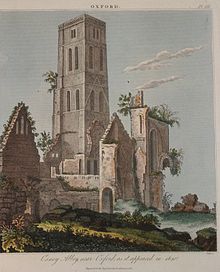|
Osney Abbey
Osney Abbey or Oseney Abbey, later Osney Cathedral, was a house of Augustinian canons at Osney in Oxfordshire.[1] The site is south of the modern Botley Road, down Mill Street by Osney Cemetery, next to the railway line just south of Oxford station. It was founded as a priory in 1129, becoming an abbey around 1154. It was dissolved in 1539 but was created a cathedral, the last abbot Robert King becoming the first Bishop of Oxford. The see was transferred to the new foundation of Christ Church in 1545 and the building fell into ruin. It was one of the four renowned monastic houses of medieval Oxford, along with St Frideswide's Priory, Rewley and Godstow. HistoryThe house was founded by Robert D'Oyly the younger, Norman governor of Oxford, prompted by his wife, Edith Forne, who, to expiate the sins of her former life as the mistress of Henry I, solicited her husband to this pious work with a story of the chattering of magpies, interpreted by a chaplain as souls in Purgatory who needed the foundation of a monastery to expiate their sins. Edith was buried in Osney Abbey, in a religious habit, as John Leland describes upon seeing her tomb as it was on the eve of the dissolution: ‘Ther lyeth an image of Edith, of stone, in th' abbite of a vowess, holding a hart in her right hand, on the north side of the high altaire’. The legendary dream of magpies was painted near the tomb. Osney was (along with St Osyth, Cirencester, Llanthony, and Holy Trinity, London), one of the great Augustinian Canon Regular houses of medieval England. It provided six of the canons of Henry II’s re-foundation of the Church of the Holy Cross, Waltham as an Augustinian house in 1177. When Waltham became an abbey in 1184, the first abbot was a canon of Osney. In 1199, the church of St George in Oxford Castle was translated and annexed to the abbey.  The most significant event in the history of the abbey came in April 1222 when the Synod of Oxford met there, charged with applying the Lateran decrees in England. When in July 1237, the papal legate Otto Cardinal Candidus came to Osney, a brawl broke out between a group of scholars from the university and the cardinal's men in which the legate's cook was killed. Otto himself was locked for safety in the abbey tower, emerging unscathed to lay the city under interdict in reprisal.[2] The current navigation of the River Thames replacing the old navigation to the east side of Osney Island, is believed to have been engineered by the canons of the Abbey to turn their mill.[3] After the abbey's surrender in 1539, it was, from September 1542 until June 1544, the seat of the new Bishops of Oxford before the see transferred to the new foundation of Christ Church. It has been described as the greatest building Oxford has lost. Great Tom, the bell described as the "loudest thing in Oxford", now hanging in Tom Tower at Christ Church, was taken from the tower of Osney Abbey on its dissolution. A good deal of the monastic property was also transferred to Christ Church, and the remains of the abbey remained as a source of building material for the city and by Charles I during the English Civil War. Drawings of the remains were commissioned by John Aubrey in 1640, and the much reduced ruins were later drawn by Thomas Hearne of St Edmund Hall in 1720. BurialsTodayAll the buildings have now been destroyed except a rubble and timber-framed structure which may date from the 15th century.[4] The remnants were Grade II listed in 1954. On the same site is the long disused Osney Mill, now converted to housing,[5] close to Osney Lock. To the east is Osney Cemetery and to the south is Osney Mill Marina, on a 500m long island originally formed for the mill. To the north are the busy arterial road leading west out of Oxford, Botley Road, and Oxford railway station. References
Bibliography
External links |
||||||||||||||||||||||||

